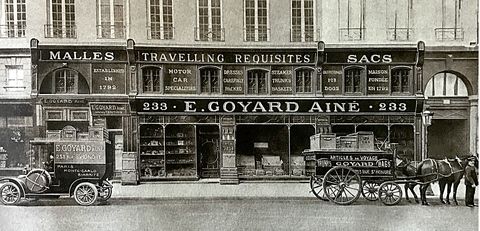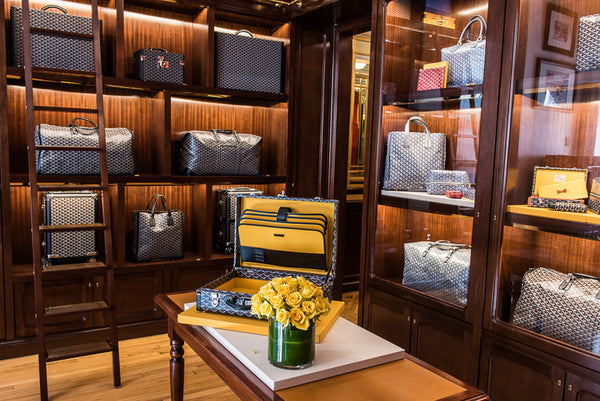Without a doubt, Goyard is one of the most prestigious and elusive designer brands in the world.
Goyard, however, did not start as Goyard. The company was founded in 1792 under the eponymous name “House of Martin,” by Pierre-Francois Martin. House of Martin specialized in box-making, trunk-making, and other pieces of luxury luggage for the French aristocracy, and Martin’s work (particularly his trunks) was extremely sought after. He even earned the title of official purveyor of Marie-Caroline de Bourbon-Siciles, the Duchess of Berry, and this helped buoy his business, in addition to many word of mouth referrals. Amid Martin’s early success, he moved the boutique from 4, rue de Nueve de Capucines (incidentally, the same address that Louis Vuitton would occupy in 1854), to 347, rue Saint-Honoré. This location, which is now under 233 rue Saint-Honoré thanks to a new street numbering policy, is where Goyard’s flagship store still resides to this day.

Pierre-Francois Martin went on to mentor an employee named Louis-Henri Morel, who in turn, took on an apprentice under the name of Francois Goyard from 1845 onwards. When Morel died some years after he first began grooming his young protégé, Goyard took over the business in 1853, renaming the company “House of Goyard” one year into his newfound ownership.
Goyard chose to follow in his predecessors’ footsteps and maintain focus on box-making, trunk-making, and other packing for the French aristocracy. After inheriting the House, Goyard opened a workshop in the Parisian suburb of Bezons, separate from their flagship store, which we alluded to earlier. He did this in order to exert maximum control over the manufacturing process and maintain exceptional quality.
Francois Goyard would go on to lead the company for another 32 years, before passing the House down to his son, Edmond, who would scale the brand to the international acclaim it enjoys today. Edmond envisioned the store as an elite institution which would serve international, upper-class clientele. In line with this aspirational branding, he renamed the company E.Goyard Ainé (Ainé translates from French to English as ‘eldest’, drawing upon the history of the company and its timeless values). Edmond opened three new stores in France, subsequently going on to create the first Goyard advertisements. On top of these accomplishments, one might argue Edmond’s greatest contribution was the introduction of the Goyardine canvas in 1892, which differentiated the company as an exceptional leader in design, materials, and utility.

The Goyardine canvas proved to be a truly disruptive product in the trunk-making industry. It is made from coated cloth, blending linen and cotton, and as such is remarkably durable, lightweight, and waterproof.
According to Edmond, he was inspired by his log-driver ancestors in creating both the material and the design of the cloth. This can be seen in the iconic piled dot pattern that forms chevrons (said to represent log stacks). These chevrons are then juxtaposed against the background color of the products to form the small and numerous letter Ys. It is these same ancestors who used these very fabrics in their water-resistant work clothes and enjoyed them specifically for their flexibility and longevity. Indeed, at a time when other trunk-makers were solely using plain linen cloth, this technical innovation distinguished Goyard’s canvas products in design and durability.

The Goyardine canvas was not only unique in its durability, but also in its visual design. Edmond himself was the first trunk maker to build his name - written in white - into the canvas, and he did this before 1900, when marquaging became popular as a means to differentiate between luggage makers. Indeed, unlike most designers, they don’t use the first initial like Chanel, Louis Vuitton, and Gucci all do to monogram their brand’s logo. Instead, they use the ‘Y’ in Goyard as their chosen motif. As of the 2000’s, this signature print is no longer hand-painted, but instead mechanically screen printed. If you are ordering a personalization, then these customizations are all hand-painted in-house by artisans at Goyard’s ateliers, while the additional detail of a crown logo still requires proof of royal ancestry!

Of course, Goyard is not limited to its famous luxury trunks - the most iconic products of theirs include their St. Louis Tote Bags, Anjou Tote bags, and small leather goods (such as their pouches, wallets, and card holders). It’s important to note that, since less people travel with trunks than in previous years, Goyard’s expansion to luxury weekend bags has been a critical product expansion that has buoyed their popularity. For instance, Goyard’s Boeing Bag and Croisiere Bag are sought after items perfect for travel, thanks to their flexible and durable canvas material, while the Savile Row Garment Bag is especially well-suited to professionals, given its more structured design and ability to easily fit in overhead luggage compartments on airplanes. On top of this, the company is known for its flexibility when it comes to creating customized pieces - for instance, Goyard made a special trunk which transformed into a portable writer’s desk for Sherlock Holmes author, Sir Arthur Conan Doyle.

Evidently, Edmond Goyard was pivotal in steering the company toward international and financial success, and up until 1998, the Goyard company’s direction, management, and success was very much a family affair. After Edmond’s death in 1937, loyal customers saw the passing of the Goyard business to Edmond’s son, Robert, who was responsible for developing and patenting the design for a new woven jacquard chevron canvas in 1965. This material, marked by its pliable, flexible nature, was suitable for use in crafting bags and wallets. Just like his father, he also ran the venture until his death in 1979, at which point the business was taken over by his granddaughter, Isabelle Goyard.

In 1998, Jean-Michel Signoles, a French businessman, struck an agreement to purchase the House from the Goyard family. Signoles’ purchase of Goyard marked the first break from the Goyard family’s line of succession in almost 150 years.

Signoles proceeded to build new workshops in France and open retail stores in select locations across North America, Europe, Asia, and South America. Goyard, however, maintains far fewer stores than other luxury brands like Louis Vuitton or Gucci. Even in countries where Goyard has a concentrated number of locations, such as France (which boasts 4 stores total, 3 of which are in Paris) and the United States (with 5 Goyard stores), it is clear that the House is not focused on expansion. Instead, the company is dedicated to offering its target market a high quality customer experience from their select, carefully-chosen locations. These locations are usually situated in the most expensive of postcodes, such as Beverly Hills, California, Mayfair, London, Highland Park, Dallas, and Place Vendôme, Paris.

Despite the change in ownership, Goyard’s missions and values seem to have been upheld and built upon in the 23 years since its acquisition. For instance, Signoles’ Goyard catalogue largely does not change from season to season; maintaining a focus on classicism and timelessness in the collection. Featured on their website is a roster of notable, long-time clients — for example the Duke and Duchess of Windsor, who began frequenting the store as early as 1939. This is testament to the fact that in today’s fast-fashion dominated landscape, Goyard retains focus on durable and timeless luxury.


Although unwavering in his commitment to Goyard’s original traditions and values, Signole’s leadership has spawned the introduction of an expanded range of ten new colors, in addition to the two traditional trims of the black Goyardine canvas. The new colours include red, orange, yellow, green, sky blue, navy blue, burgundy, white, and gray. Pink was briefly introduced and subsequently discontinued in the late 2000's. The new hues brought a vibrant pop of colour to the newly introduced bags and small leather goods in addition to the more traditional luggage and trunks. These new small leather goods span a variety of products, including their Saint Sulpice and Saint Marc card holders, Saint Louis pouches, Saint Victoire and Saint Florentin wallets. As mentioned earlier, though Goyard earned its prestigious reputation in the art of trunk-making, hard-sided luggage is now in less demand in the age of personal automobiles and airplanes. Goyard’s product ranges (and store layouts) reflect this change. For instance, one can see on Goyard’s Twitter account, in which they post pictures of their stores, that the most critical real estate in the boutique is dedicated to their luxury bags and wallets. In particular, the St. Louis, Anjou, Belvedere, Jeanne, and Voltaire bags occupy the most attention-grabbing spaces in the windows, in addition to popular small leather goods like the Plumet Pouch, Sénat Pouch, and the Saint Pierre Card Holder, which all perfectly complement the larger totes on Goyard’s shelves. While increasingly ornamental, larger hard-sided luggage from the brand encompasses and displays the brand’s history and savoir-faire, now translated in the bags and leather goods of the present day.

These deeply-entrenched traditional values that Goyard is known for also permeate their marketing, sales, and in-person stores. Goyard does not engage in digital advertising (which may be why they are lesser known than other houses), and they don’t allow purchases to be made through their website. In fact, they explicitly state on their website that they “don’t engage in e-commerce in any way.” Instead, customers need to visit one of their 8 stores in the US (located in New York, LA, San Francisco, Dallas, Chicago, and Miami), or any of the other select number of cities which house a Goyard boutique (of which there are less than 25 total).

Despite their eschewing of mass marketing, Goyard’s popularity has not waned in recent years. Well-known celebrities such as Kanye West, Hilary Duff, Selena Gomez, Pharell Williams, Nicole Richie, Meghan Markle, and the Kardashians all have been spotted with popular Goyard pieces such as the St.Louis Tote bag and Ambassade briefcase.
Goyard’s thoughtful, striking pieces remain just as timeless today as they were in 1853.

